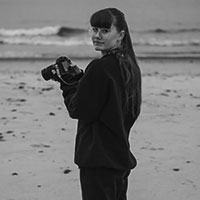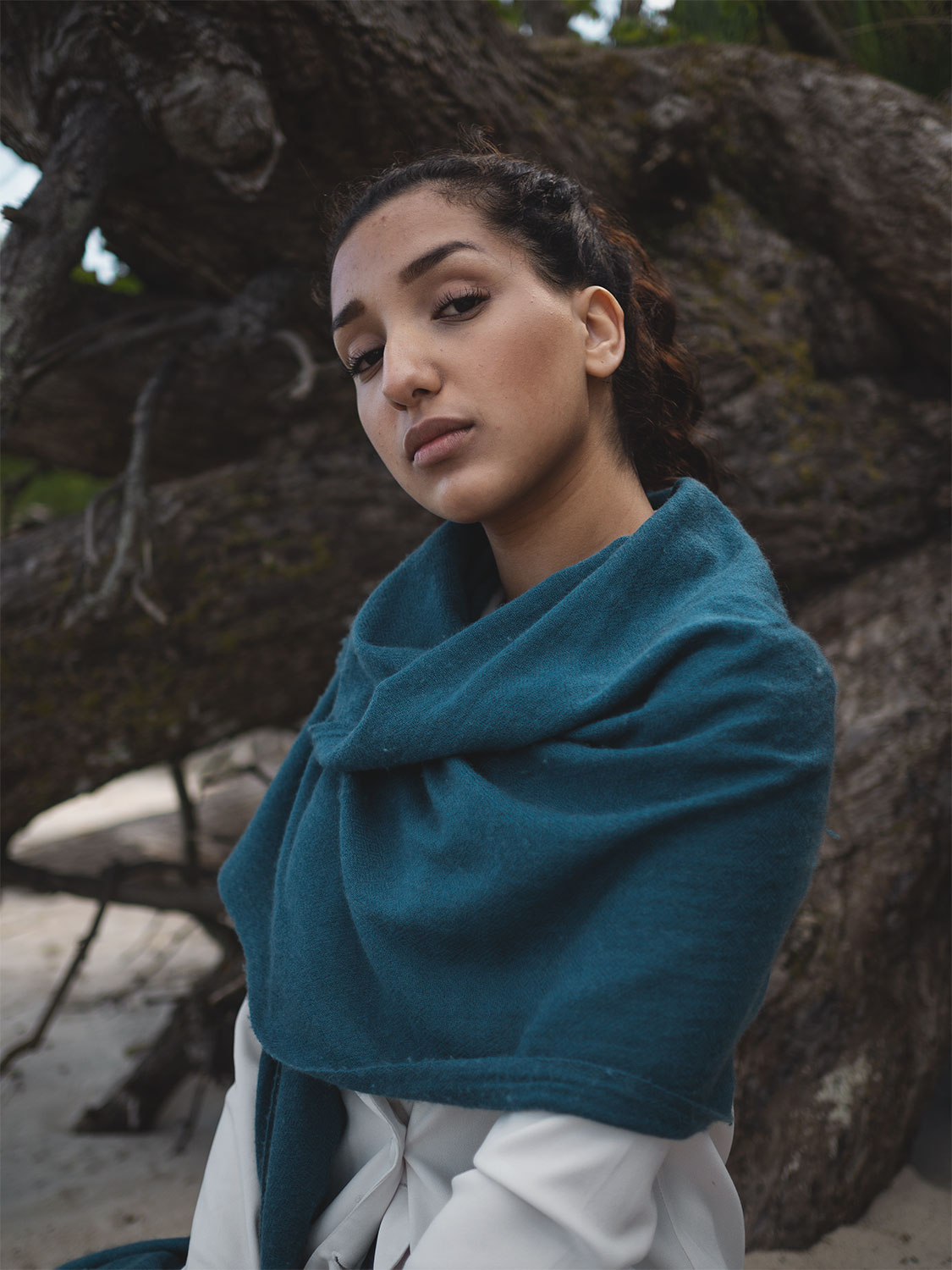My way into portrait photography
Hi there, my name is Vija Priedite Kvie, and I’m a 20-year-old photographer from Skåne, Sweden. Currently, I’m starting my own photography business, taking yet another course in photography, and when I’m not focusing on camera-related things, I work in a chocolate factory.
All my life I’ve highly valued creativity. This includes everything from making small figures out of stone as a child, to now expressing myself through pictures and photography. My big interest in photography started when I bought my very own DSLR as a 13-year-old.
I had been saving for a while, done a lot of research, and finally found one that seemed just perfect. That summer was spent learning all about my camera and taking pictures of everything! After some time, it all cooled down a bit, and I started to draw and paint instead, still expressing myself through pictures, but with different kinds of mediums.
Two years later, I started what in Sweden may be equivalent to what other countries call high school. I chose to study an art program. My first year in school I spent with a pen in my hand, but when we later got to take a photography course that pen was quickly traded for a camera, I was once again hooked and has been ever since.
RIGHT: Olympus E-M10 MK III . Olympus M.Zuiko 25mmF1.8 . F/2.0 . 1/160” . ISO 100
During my years in the art program, I found a fascination for analog photography and portraits. Something about the preciseness and long process interested me and sparked my curiosity. As I started to learn more about analog photography and developed my skills, I found one specific camera, borrowed from my school, that I liked to work a lot with. Not surprisingly, it was the Olympus OM-1. This camera made me buy my own OM-2n later on too.
In 2018 I participated in a photography marathon with the challenge of taking 12 pictures on 12 different themes during only 6 hours. The first-prize was the Olympus OM-D E-M10 Mark III, a camera I really wanted, especially after my experience with the OM-1.
The marathon was very fun, a bit stressful, and my creativity was put to the test. A month later the winners were announced, I won the whole competition for my overall performance. In other words, the camera was mine. Since then, I have been using it with love, the camera itself reminds me of the good day I won.
Right now, one of the lenses I use the most is the M.Zuiko 25mm F1.8 with my Olympus OM-D E-M10 Mark III. It’s a lens and camera that have taught me a lot and has been with me for a long time. I like that the camera body is so small, it makes it super easy to have with you everywhere, and you never miss an opportunity to shoot.
You don’t have to think about it taking up a lot of space in your bag, and it’s super lightweight. When using my old DSLR, I often left the camera at home because it was very clumsy and heavy. This resulted in a lot of missed opportunities.
I had always used a 50mm 1.8 lens with DSLR cameras, so I didn’t have to think a second about buying the M.Zuiko 25mm when I got my Olympus body. It was a natural choice. The amount of light the lens lets in is very important for me, especially when working with natural light.
When shooting portraits with only natural light, your surrounding is something to pay attention to, especially if it’s super bright outside and the sun is shining. Something to think about is to avoid harsh shadows in the face unless it’s done with a specific purpose and awareness.
Having even light and softer shadows over the face can help and make it easier to create an even skin texture while reducing the risk of your model looking tired or even older than wanted. When it comes to harsh lights, they can easily create unwanted lines and unflattering shapes, like shadows under the eyes and from the nose.
This can be fixed by having your model looking up towards the light source, putting on a hat, and even creating a shadow over your face using your hand. Be creative and have fun with the light, but never forget the importance of being aware of it.
For myself, I’m almost always looking for shade in different ways when shooting portraits in harsh light. Either I’m searching for larger parts of shade where you can place the model under, or if possible, even find a shadow that you can play with and create shadows for added texture and creativity.
RIGHT: Olympus E-M10 MK III . Olympus M.Zuiko 25mmF1.8 . F/1.8 . 1/400” . ISO 100
When shooting, I preferably look for moodier days with a lot of clouds and fog. I’m very drawn to the even light the clouds give you, they work like a huge softbox. The color pallet gets super nice and creates an outstanding feeling in the portraits that I appreciate.
The locations of my photo sessions play a big role and are something I choose carefully. To create contrasts between the model, the outfit and the surroundings are something I work a lot with for an image to appear interesting. I’m extra drawn to having my photographs being taken at the shoreline.
How the light is reflected off the sea, the stripped-down color palette, these are things that inspire me a lot. I am lucky enough to live by one of the southern coasts of Sweden. We have long white beaches, often with fallen trees, which makes some amazing props to create an interesting environment.
RIGHT: Olympus E-M10 MK III . Olympus M.Zuiko 25mmF1.8 . F/1.8 . 1/4” . ISO 100
When I use the M.Zuiko 25mm F1.8 and also the 45mm F1.8 lenses, I usually have the aperture down to 1.8~2.2. When using a lens with such a low aperture number, the main focus can be on the colors rather than what’s going on in the background. To make the model stand out and pop clearly out of the background, I often choose lighter colored outfits.
When the background is mostly dark, I tend to use lighter outfits and vice versa for lighter backgrounds. Thinking about shapes, colors, and framing will help a lot in making your model stand out from whatever is surrounding them. Take advantage of arches, branches, openings, and other things that frame the object to create balance in your image.
RIGHT: Olympus E-M10 MK III . Olympus M.Zuiko 45mmF1.8 . F/1.8 . 1/2500” . ISO 100
Editing my pictures is an important step for me. Mostly I focus on color correction and creating the color palette I want. While editing, I also bring out the impression I want to convey in the pictures. Camera Raw is my go-to working space as I always shoot in raw. Shooting in this format has many benefits and gives me full control over the images after they are taken.
This is very helpful in many different situations, for example, when taking street photos where you sometimes quickly have to set the settings, so you don’t miss the moment you want to shoot. The settings can easily become a bit off, and the image may be over or underexposed. With raw format, this is easily corrected afterwards. All information remains, you get large files with high quality, and no compression of the files occurs.
To give a lot of my pictures the feeling I’m looking for, I use my own created presets. The ones most frequently used have low saturated colors, soft shadows, warmer tones and low contrast. The existing profiles are only the foundation.
With a lot of things said, I can’t stress enough how important it is to have fun while working with photography. No matter if it’s as a profession or just as a hobby. Dare to break the rules, find your own expression, explore your limitations, be creative.
RIGHT: Olympus E-M10 MK III . Olympus M.Zuiko 25mmF1.8 . F/2.0 . 1/50” . ISO 100

“My name is Vija Priedite Kvie, and I’m a 20-year-old photographer. My interest in photography really took off In high school, when I got valuable tools for the first time. It didn’t take long before I got hooked on personal portraits. Capturing a human being in their true self became something of a task I felt motivated to continue with. I’m now starting my own photography business in the south of Sweden.”

























